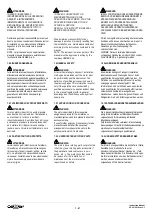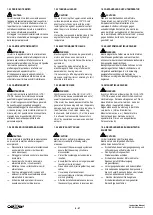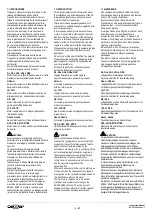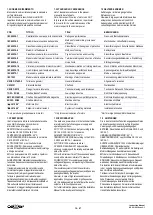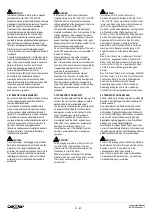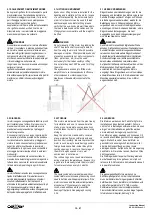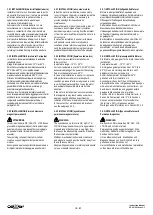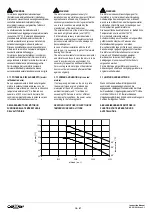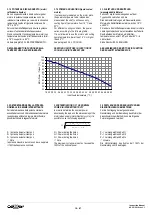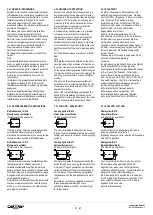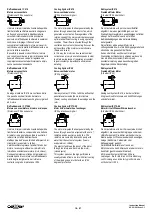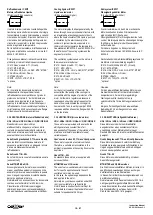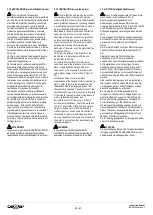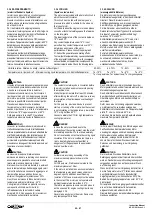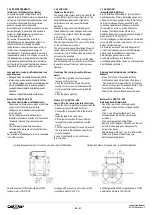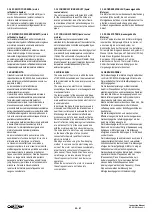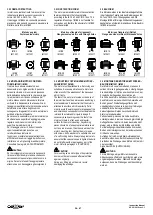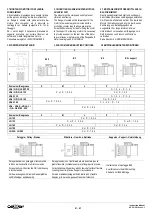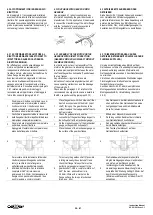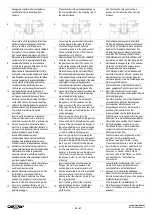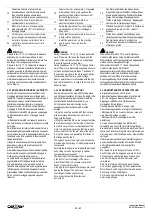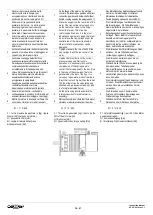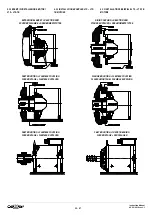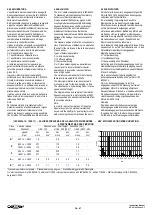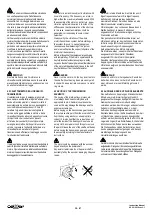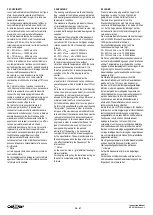
21 - 97
Instruction Manual
AC 02/2019-rev.1.1
3.3.3 VENTILAZIONE (motori raffreddati ad aria)
Fare in modo che l’aria aspirata
dall’elettroventilatore sia sempre fresca, pulita ed
asciutta. Per i motori installati nella struttura della
macchina e/o protetti da pannelli di copertura è
as
solutamente necessario che l’aria aspirata
dall’elettroventilatore sia prelevata dall’ambiente
mediante apposite canalizzazioni e scaricata
sempre nell’ambiente per mezzo di aperture di
ventila
zione. L’aspirazione dell’aria fresca e lo
scarico di quella calda dovranno essere poste il
più lontano possibile l’una dall’altra e non
dovranno mai innescare cicli viziosi. La distanza
minima tra la struttura della macchina e lo scarico
dell’aria calda d
el motore deve essere di almeno
50-70 mm.
Verificare che il senso di rotazione della girante
dell’elettroventilatore sia concorde con quello
indicato dall’apposita freccia.
Per installazioni in condizioni ambientali difficili
dovute alla presenza di molta polvere, acqua,
forte umidità, nebulizzazioni, vapori d’acq
ua-olio-
solventi, etc. è necessario prevedere motori con
grado di protezione aumentato (IP 54 o IP 55).
In queste condizioni di impiego è anche richiesta
la manutenzione periodica del ventilatore e del
motore per rimuovere i depositi di sporco dalle
palette della girante/ventola e dai canali di
ventilazione. L’ostruzione dei canali di
ventilazione o la riduzione della portata della
ventola causata dallo sporco possono causare
surriscaldamento del motore e perdita di potenza.
Per installazioni di motori IP 23S in condizioni
ambientali difficili dovute alla presenza di molta
polvere, acqua, forte umidità, nebulizzazioni,
vapori d’acqua
-olio-solventi, etc. è necessario
prevedere delle canalizzazioni che consentano il
raffreddamento del motore con aria fresca e
pulita verificando che la quantità d
’
aria immessa
nel motore non sia inferiore a quella indicata sul
catalogo tecnico.
ATTENZIONE
In ogni caso i motori descritti NON SONO IDONEI
ad essere installati in ambienti che richiedano
l’applicazione di motori a
ntideflagranti (Eex / Atex).
3.3.3 VENTILATION (air cooled motors)
Be sure that the air drawn by the electric
fan is always fresh, clean and dry. For the
motors installed in the structure of the machine
and/or protected by panels or covering cabinets
it is absolutely necessary that the air is picked
up from the ambient through ducts and
discharged in the ambient through ventilation
openings. The suction of cool air and the
discharge of the warm one shall be positioned
as far as possible and, at any rate, shall not
cause vicious cycles. The minimum distance
between the machine structure and the
discharge of the warm air of the motor shall be
at least 50-70 mm.
Verify that the rotation of the impeller of the
electric fan is in accordance with the one
indicated by the arrow.
For installations in difficult environmental
conditions, due to the presence of a lot of dust,
water, strong humidity, sprays, steam, oil
solvent, etc. it is necessary to provide motor
with a higher degree of protection IP 54 or IP
55).
In these condition of use, a periodic
maintenance of the fan and motor is required as
well, in order to remove the dirt deposits from
the blades of the impeller/propeller and from
the ventilation channels. The obstruction of the
ventilation channels or the reduction in flow rate
of the impeller caused by the dirt may induce a
motor overheating and power loss.
For installations of IP 23 motors in difficult
environmental conditions, due to the presence
of a lot of dust, water, strong humidity, sprays,
steam, oil solvent, etc. provision should be
made for ducts or air-channels which allow for
the cooling of the motor with clean and fresh
air. Also check that the volume of air drawn into
the motor is no less than that described in the
technical catalogue.
WARNING
In any case the motor described ARE NOT
SUITABLE to be
installed in ambient requiring the
application of explosion rated motors (Eex / Atex).
3.3.3 LÜFTUNG( luftgekühlte Motoren)
Die vom Lüfter angesaugte Luft muss immer
frisch, sauber und trocken sein. Für im
Maschinengestell eingebaute u/o von
Abdeckungen umschlossene Motoren muss
immer gewährleistet sein, dass Frisch- oder Abluft
durch entsprechende Lüftungskanäle und
Öffnungen angesaugt bzw. ausgeblasen werden
kann.
Das Ansaugen der Frischluft und das Ausblasen
der Warmluft muss örtlich weit möglichst getrennt
werden und darf niemals zu Kurzschlüssen
führen.
Der minimale Abstand zwischen Maschinenteilen
und Warmluftauslass des Motors beträgt 50-70
mm.
Überprüfen, dass die Drehrichtung des
Lüfterrades mit der Richtung des dafür
angebrachten Drehrichtungspfeiles übereinstimmt.
Für Installationen unter schwierigen Umwelt-
bedingungen aufgrund von hohem Staubanfall,
Wasser, hoher Feuchtigkeit, Nebel, Öl-Wasser-
Lösungsmitteldämpfe usw. müssen Motoren mit
erhöhtem Schutzgrad (IP54 oder IP55) eingesetzt
werden.
Unter solchen Bedingungen ist eine periodische
Wartung des Lüfters und des Motors notwendig,
um Ablagerungen auf den Lüfterflügeln und aus
den Lüftungskanälen zu entfernen.
Ein Verstopfen der Lüftungskanäle und ein
verringerter Luftstrom durch Ablagerungen auf
den Lüfterflügeln können eine Überhitzung des
Motors oder Leistungseinbussen verursachen.
Für Installationen von IP23 Motoren unter
schwierigen Umweltbedingungen aufgrund von
hohem Staubanfall, Wasser, hoher Feuchtigkeit,
Nebel, Öl-Wasser- Lösungsmitteldämpfe usw. ist
es notwendig Lüftungskanäle für die Zufuhr von
sauberer Frischluft vorzusehen.
Die im Katalog angegebene Luftmenge darf dabei
nicht unterschritten werden.
ACHTUNG
Die beschriebenen Motore sind für einen Installation
in Umgebungen NICHT ZUGELASSEN, die einen
Explosionsschutz verlangen (Eex / Atex).
Содержание HQCA
Страница 2: ...2 97 Instruction Manual AC 02 2019 rev 1 1...

